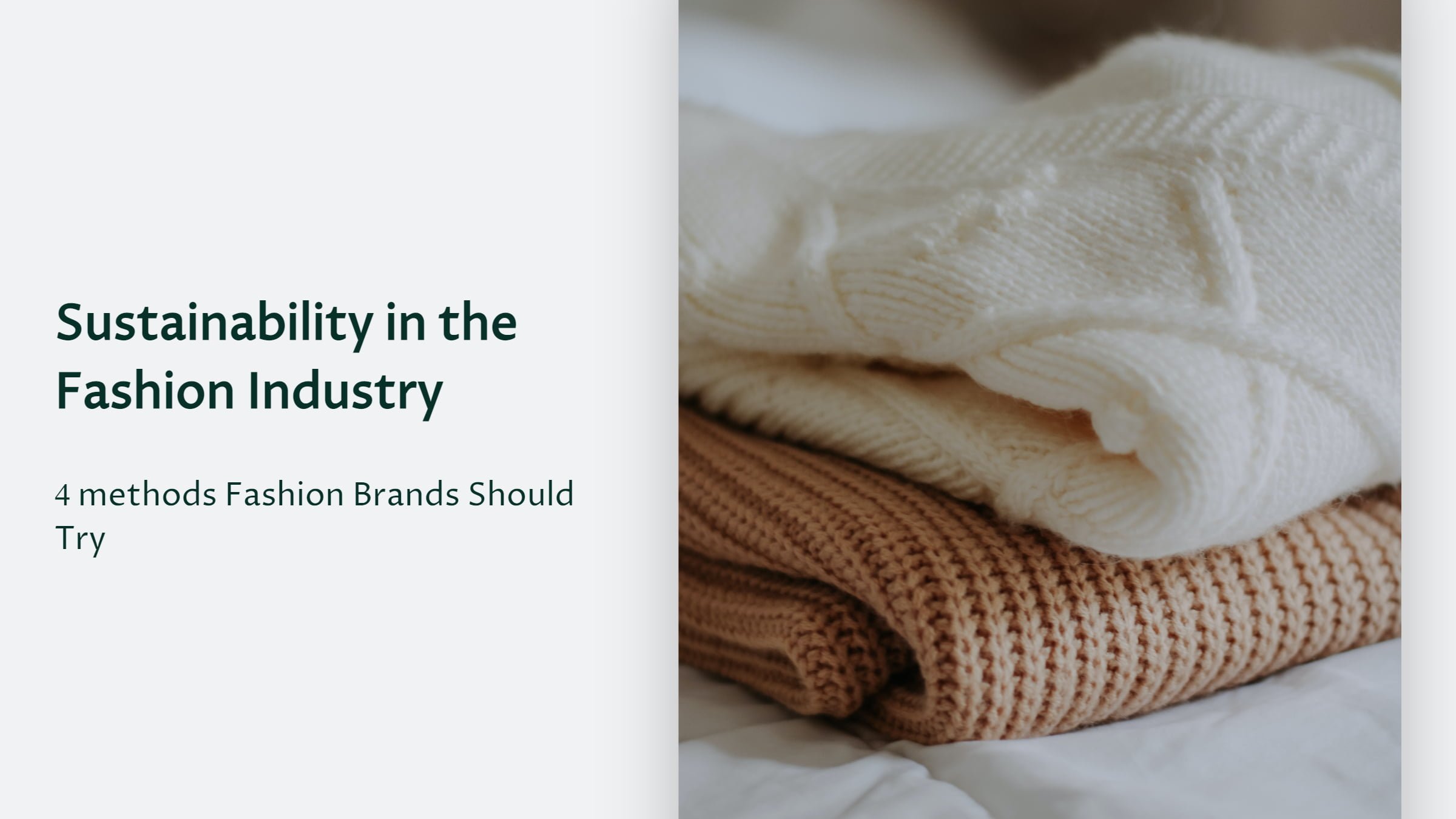

Sustainability in the Fashion Industry: 4 Methods Every Fashion Brand Should Implement

As Seen On
As the fashion industry continues to grow, so does its environmental impact. From the production of materials to clothing disposal, the fashion industry has a significant carbon footprint and contributes to pollution and waste.
However, it doesn’t have to be this way. There are many ways that sustainability in the fashion industry can be achieved, and in this blog post, we’ll explore some ways that brands can reduce their environmental impact.

From using sustainable materials to implementing eco-friendly production methods and reducing waste, there are several ways that fashion brands can make a positive difference.
So, whether you’re a fashion brand looking for ways to become more sustainable or a conscious consumer looking for eco-friendly options, this blog post is for you.
Let’s dive in and see how fashion brands can be more sustainable!
Table of Contents
The importance of Sustainability in the Fashion Industry:
Sustainability has become increasingly important in the fashion industry in recent years as consumers become more aware of the environmental impact of their clothing and the industry as a whole.
The fashion industry is a major contributor to pollution and waste, and it has a significant carbon footprint due to the production of materials and the transportation of goods.
In addition to the environmental concerns, there are also social and economic reasons why Sustainability is essential in the fashion industry. Poor working conditions and low wages in the industry have been well documented, and sustainable practices can help to improve working conditions and support fair labour practices.
By adopting sustainable practices, fashion brands can reduce their environmental impact and improve the social and economic well-being of their employees and the communities in which they operate. In turn, this can lead to increased consumer trust and loyalty, as well as potential cost savings and increased profits.
Overall, Sustainability is becoming increasingly important in the fashion industry, and brands must take steps to reduce their environmental impact and support social and economic Sustainability.
The different ways Fashion Brands can be sustainable:
Using sustainable materials:
One of the most impactful ways fashion brands can be more sustainable is by using sustainable materials in their products. Sustainable materials are those produced in an environmentally-friendly manner, such as organic cotton, which is grown without harmful pesticides and fertilizers.
Other sustainable materials include recycled polyester, made from post-consumer plastic bottles, and Tencel, made from wood pulp and fully biodegradable. Using these materials can significantly reduce the fashion industry’s carbon footprint and decrease the amount of waste it produces.
In addition to their environmental benefits, sustainable materials can be softer, more durable, and more comfortable to wear, making them a win-win for both brands and consumers. By prioritizing sustainable materials, fashion brands can not only reduce their environmental impact but also create products that are more appealing to consumers.

Implementing eco-friendly production methods:
In addition to using sustainable materials, fashion brands can also be more sustainable by implementing eco-friendly production methods. It can include a wide range of practices, such as using renewable energy sources, reducing water usage, and using non-toxic chemicals in the production process.
By adopting these practices, fashion brands can significantly reduce their environmental impact and create a healthier and safer working environment for their employees.
Eco-friendly production methods can also have economic benefits for fashion brands. For example, using renewable energy sources can lead to cost savings in the long term, as it reduces a brand’s dependence on fossil fuels.
Similarly, reducing water usage can reduce the costs associated with water treatment and disposal. By implementing eco-friendly production methods, fashion brands can not only do their part to protect the environment but also save money and potentially even increase their profits.
Overall, eco-friendly production methods are an essential aspect of Sustainability in the fashion industry, and brands must prioritize these practices to create a more sustainable future for all of us.
Reduce Waste:
Reducing waste is another important aspect of sustainability in the fashion industry. From the production of materials to clothing disposal, the fashion industry generates significant waste. Brands must take steps to reduce this waste to protect the environment.
There are many ways that fashion brands can reduce their waste, such as offering repair and alteration services, implementing a take-back program for used clothing, and using packaging that is made from recycled materials. By taking these steps, brands can reduce their environmental impact, save money, and increase their profits.
In addition to the benefits for the environment and the bottom line, reducing waste can also have social and economic benefits.
For example, take-back programs can create job opportunities for those who repair and alter clothing. Using recycled materials can support the recycling industry and promote circularity in the fashion industry.
Overall, reducing waste is an essential aspect of sustainability in the fashion industry, and brands must prioritize waste reduction to create a more sustainable future for all of us.
Transparency:
In addition to using sustainable materials, implementing eco-friendly production methods, and reducing waste, fashion brands can be more sustainable by being transparent about their sustainability efforts. Transparency is important to sustainability, as it allows consumers to make informed and ethical purchasing decisions.
There are many ways that fashion brands can be transparent about their sustainability efforts. For example, they can disclose information about the materials they use, the production methods they employ, and the waste reduction efforts they have in place.
They can also provide information about their factories’ supply chain and working conditions. By sharing this information with consumers, brands can encourage them to make more sustainable purchasing decisions and build trust with their customers.
Transparency can also have economic benefits for fashion brands. By being open about their sustainability efforts, brands can differentiate themselves from competitors and potentially even command a higher price for their products.
In addition, transparency can lead to increased consumer loyalty, as consumers are more likely to continue purchasing from brands they trust and respect.
Overall, transparency is an essential aspect of sustainability in the fashion industry, and brands must prioritize transparency to create a more sustainable future for all of us.
The Bottom Line:
In conclusion, there are many ways that fashion brands can be more sustainable, including using sustainable materials, implementing eco-friendly production methods, reducing waste, and being transparent about their efforts.
By adopting these practices, fashion brands can reduce their environmental impact and improve the social and economic well-being of their employees and the communities in which they operate. In turn, this can lead to increased consumer trust and loyalty, as well as potential cost savings and increased profits.
Fashion brands must prioritize sustainability to create a better future for all of us. The fashion industry has a significant impact on the environment and society, and it is our responsibility to ensure that this impact is as positive as possible.
By working together, fashion brands and consumers can create a more sustainable fashion industry that benefits us all.
Konger
Up until working with Casey, we had only had poor to mediocre experiences outsourcing work to agencies. Casey & the team at CJ&CO are the exception to the rule.
Communication was beyond great, his understanding of our vision was phenomenal, and instead of needing babysitting like the other agencies we worked with, he was not only completely dependable but also gave us sound suggestions on how to get better results, at the risk of us not needing him for the initial job we requested (absolute gem).
This has truly been the first time we worked with someone outside of our business that quickly grasped our vision, and that I could completely forget about and would still deliver above expectations.
I honestly can't wait to work in many more projects together!
Disclaimer
*The information this blog provides is for general informational purposes only and is not intended as financial or professional advice. The information may not reflect current developments and may be changed or updated without notice. Any opinions expressed on this blog are the author’s own and do not necessarily reflect the views of the author’s employer or any other organization. You should not act or rely on any information contained in this blog without first seeking the advice of a professional. No representation or warranty, express or implied, is made as to the accuracy or completeness of the information contained in this blog. The author and affiliated parties assume no liability for any errors or omissions.